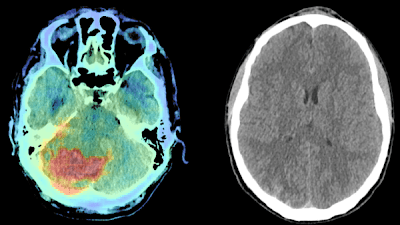|
ICH AI Efficiency | Healthcare Goes Home
February 13, 2022
|
|
|

|
|
Together with
|

|
|
|
“Patients are tired of a health care system that doesn’t put them first. Our patient-centric service is changing that, one visit at a time.”
|
|
Amazon Care’s Kristen Helton, announcing Amazon’s healthcare expansion.
|
|

|
|
A new Radiology: Artificial Intelligence study out of Switzerland highlighted how Aidoc’s Intracranial Hemorrhage AI solution improved emergency department workflows, without hurting patient care. Even if that’s exactly what solutions like this are supposed to do, real world AI studies that go beyond sensitivity and specificity are still rare and worth some extra attention.
The Study – The researchers analyzed University Hospital of Basel’s non-contrast CT intracranial hemorrhage (ICH) exams before and after adopting the Aidoc ICH solution (n = 1,433 before & 3,017 after; ~14% ICH incidence w/ both groups).
Diagnostic Results – The Aidoc solution produced “practicable” overall diagnostic results (93% accuracy, 87.2% sensitivity, 93.9% specificity, and 97.8% NPV), although accuracy was lower with certain ICH subtypes (e.g. subdural hemorrhage 69.2%, 74/107).
Efficiency Results – More notably, the Aidoc ICH solution “positively impacted” UBS’ ED workflows, with improvements across a range of key metrics:
- Communicating critical findings: 63 vs. 70 minutes
- Communicating acute ICH: 58 vs. 73 minutes
- Overall turnaround time to rule out ICH: 164 vs. 175 minutes
- Turnaround time to rule out ICH during working hours: 167 vs. 205 minutes
Next Steps – The authors called for further efforts to streamline their stroke workflows and to create a clear ICH AI framework, accurately noting that “AI tools are only as reliable as the environment they are deployed in.”
The Takeaway
The internet hasn’t always been kind to emergency AI tools, and academic studies have rarely focused on the workflow efficiency outcomes that many radiologists and emergency teams care about. That’s not the case with this study, which did a good job showing the diagnostic and workflow upsides of ICH AI adoption, and added a nice reminder that imaging teams share responsibility for AI outcomes.
|




|
|
Arterys’ AI Journey
Check out this Imaging Wire Q&A, where Arterys CEO John Axerio-Cilies, PhD discusses medical imaging’s AI and cloud evolution and how Arterys works with its Center of Excellence partners to make AI real.
|
|
- Imaging’s Mixed Q4: After a year of solid growth, supply chain headwinds drove mixed healthcare/imaging division revenues from the major Imaging OEMs during the October-January period. Fujifilm once again posted the greatest healthcare growth due in part to its Hitachi integration (+43.6% to $1.73B), followed by Siemens Healthineers’ imaging business (+5.9% to $2.89B), Hologic’s breast imaging division (+5.5% to $282M), and Canon Medical Systems (+4.6% to $1.1B). Meanwhile, supply chain and other issues resulted in flat growth within Philips’ Diagnosis & Treatment division ($2.86B) and Konica Minolta’s healthcare division ($243M), and another YoY decline from GE Healthcare (-4% to $4.3B).
- CMS Expands LDCT Coverage: CMS is officially expanding Medicare coverage for low-dose CT lung cancer screening to younger people with shorter smoking histories (50-77 vs. 55-77 age range; 20 vs. 30 smoking pack-years), aligning with the USPSTF’s early 2021 recommendations. As part of the coverage expansion, CMS scaled back requirements for reading radiologists (less education documentation), imaging facilities (not required to participate in registry), and counseling and shared decision-making (can be provided by non-clinical staff).
- Mammography AI + Density Detection: A new study out of The Netherlands suggests that combining mammography AI detection and breast density measurements could identify more women who would be diagnosed with interval breast cancers. The researchers developed a neural network combining ScreenPoint Transpara and an open-access breast density solution using exams from 4,819 women (1,556 w/ interval cancers). When tested against exams from 2,064 women (666 w/ interval cancers), the combined solution identified the women who would have interval cancers with a 0.79 AUC, higher than the AI and breast density systems on their own (0.73 & 0.69).
- Amazon Telehealth: After launching as an internal service in 2019, Amazon is now expanding its Amazon Care health offering to employers across the US. Amazon Care’s hybrid model consists of: (1) telehealth-based primary care delivered by a dedicated Care Medical doctor and (2) nurse practitioners dispatched to patient homes when medical needs can’t be resolved over video. Although the announcement didn’t mention imaging, it’s another solid reminder that all specialties should be monitoring the shift towards hybrid care.
- MRI Metamaterial Helmet: Boston University Photonics Center scientists reached another milestone in their metamaterial MRI research, developing a metamaterial helmet that improves low-field brain MR image quality at 2x normal scan speeds. This is the BU team’s first wearable metamaterial, after unveiling a flat array design several years ago.
- Qure.ai’s NHS Support: Qure.ai landed £3.2M in NHS funding that it will use to support research into how its qXR AI tool might improve the NHS’s lung cancer detection workflows. The feasibility study would specifically explore qXR’s impact on chest X-ray lung nodule detection and reporting, and its downstream impact on lung cancer diagnosis times and costs.
- Cholesterol’s CAC Caveat: A new JAMA study suggests that patients with severely elevated low-density lipoprotein cholesterol levels (LDL-C, ≥190 mg/dL) might not actually be at high risk for atherosclerotic cardiovascular disease (ASCVD) events if they have low CTA-based CAC scores. The study of 23,143 symptomatic patients (58yrs avg age, 4.2yr avg follow-up, 1,029 ASCVD events) found that patients with both extremely high cholesterol and 0 CAC scores (46% of high LDL-C patients) had comparable ASCVD event rates to the overall population (6.9 vs. 6.3 events per 1k person years).
- More Home Healthcare: McKinsey forecasts that $265B of care services could switch from traditional facilities to the home by 2025, representing a 4x increase from today. Although radiology won’t be involved in much of this shift (e.g. hospice, behavioral health, dialysis), we’re already seeing major home care providers like DispatchHealth bolster their imaging capabilities and new efforts from the UK NHS to create home X-ray teams.
- Cleerly 2.2.0: Cardiovascular AI startup Cleerly celebrated Heart Month with the release of Cleerly v2.2.0, adding new features to help clinicians and patients understand disease state, track progression, and support image sharing. Cleerly v2.2.0 now represents plaque measurements from coronary CTA scans as a percentage of total vessel volume (previously only as plaque volume), adds a new comparison tool that tracks disease by the amount and type of plaque in side-to-side views, and integrates with Ambra’s image sharing platform.
- US Radiology’s Jersey Expansion: US Radiology Specialists’ nationwide expansion continued into New Jersey with its acquisitions of South Jersey Radiology Associates (41 radiologists, 11 locations) and Larchmont Imaging Associates (24 radiologists, 6 locations). The New Jersey acquisitions (first reported by Radiology Business) continue US Radiology Specialists’ rapid expansion, growing from a Charlotte-area private practice to over 180 locations and 15 states in under four years.
- 3D UHF Ultrasound Alliance: FUJIFILM VisualSonics and PIUR Imaging launched a partnership to create and distribute 3D ultra-high-frequency (UHF) ultrasound imaging systems. The companies will combine PIUR’s tUS Infinity platform (transforms 2D ultrasound into 3D tomographic ultrasound) with FUJIFILM VisualSonics’ Vevo MD UHF ultrasound imaging systems, allowing clinicians and researchers to visualize and measure ultrasound volumes in 3D.
|
|
- Did you know 80% to 90% of sonographers experience pain while performing scans at some stage in their career? Check out this Canon Medical Systems video detailing its latest innovations that improve sonographer comfort and help reduce risk of injury.
- It says a lot when a solution works so well for a radiology department that they decide to perform a study to quantify its benefits. In this Imaging Wire Q&A, University Hospital of Zurich’s Thomas Frauenfelder discusses his experience and study on Riverain Technologies ClearRead CT.
- Do your radiologists want faster and less manual access to imaging studies? See how the Indiana Health Information Exchange (IHIE), the largest inter-organizational clinical data repository in the US, cut its imaging study retrieval time by 94% when it adopted Nuance PowerShare.
- See why the time is right for imaging AI-enabled population health in this Hardian Health profile featuring Nanox AI’s Zohar Elhanani.
- Change Healthcare’s cloud-native, zero-footprint Stratus Imaging PACS is now in clinical use by StatRad, a 90-radiologist teleradiology practice serving hundreds of hospitals across the United States.
- See how Novarad’s CryptoChart solution allowed Central Ohio Primary Care (COPC, 70 practices, 400 physicians) to make the transition to digital imaging sharing in this Healthcare IT News case study.
- Despite significant interest, there’s still confusion about the value of imaging AI. This Blackford Analysis white paper explores the key cost considerations and ROI factors that radiology groups can use to figure out how to make AI valuable for them.
|
|
|
|
|